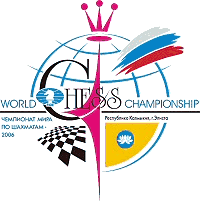
Veselin Topalov vs Vladimir
Kramnik
Twelve games, played from September 23 to October 12 in Elista, Kalmikia.
The games start at 15:00h (3:00 p.m.) local Elista time, which translates
to 11:00h GMT, 13:00h CEST, 12:00h London, 7 a.m. New York. |
|
| Live coverage is available on the official
FIDE site and on Playchess.com
(with live audio commentary by GM Yasser Seirawan for ten Ducats
per day). You can buy them in the ChessBase
Shop. |
Game seven – Wednesday, October 4th
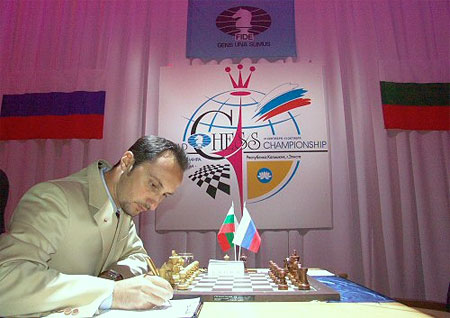
Veselin Topalov arrives first at the board for game seven
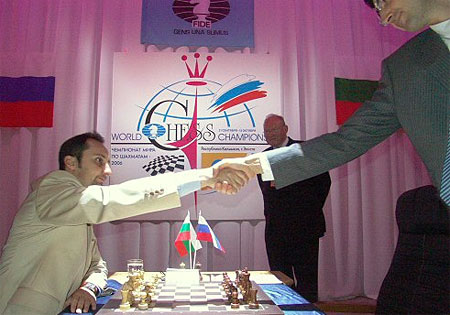
Enter Kramnik, handshake. You can study their smiles for traces of warmth.

The game begins, and our commentator Marin can get to work...
The following express commentary was provided to us by Romanian GM
Mihail Marin, who is the author of a number of very popular ChessBase
training CDs and articles for ChessBase Magazine. GM Marin will study the game
from the World Championship in Elista in greater detail and provide the results
of his analysis in the next issue of ChessBase
Magazine. Note that there is a replay link at the end of the game.
Clicking this will produce a (separate) JavaScript replay window, where you
have replay buttons but can also click on the notation to follow the moves.
Topalov,V (2813) - Kramnik,V (2743)
[D27] WCh Elista RUS (7), 04.10.2006
Topalov could not get any significant advantage from his (practically)
third game with White in a row. His only chance for attack consisted of a more
resolute advance of the g-pawn on the 25th move. Later, he sacrificed two pawns
in order to get some activity, but his initiative was just sufficient to maintain
the balance even. 1.d4 d5 2.c4 c6 3.Nf3 Nf6 4.e3

The game after 4.e3 – Kramnik pauses to contemplate his decision
Both players remain consequent to their match strategy displayed so far. Kramnik
sticks to the same openings (well, the fifth game was an exception; we can
hardly call it "a Catalan") while Topalov tries to find the Achilles'
heel in the opponent's preparation by permanently changing the systems of development.
4...e6 5.Bd3 dxc4 6.Bxc4 c5. But this is a deviation from the mentioned
pattern already: although the game started as a Slav, it transposed now to
a genuine... Queen's Gambit Accepted! I suppose that Kramnik did not play 2...dxc4
in order to avoid the sharp lines based on 3.e4, consequent to his policy of
playing solid, though sometimes passive positions with Black. 7.0-0 a6 8.Bb3
cxd4 9.exd4 Nc6 10.Nc3 Be7 11.Re1 0-0. Kramnik has considerable (and rather
successful) experience with this position as... White! It might seem as if
Topalov intended to confront his opponent with the difficult psychological
situation of playing "against himeslf", but the next move clearly
speaks against this hipotesis. 12.a4. A practically unexplored move.
White usually develops his queen's bishop to f4 or g5.
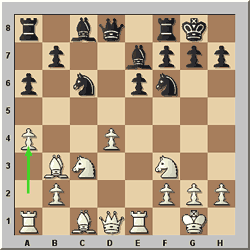
The position bears some similarity with those arising after the 6.a4 system,
but I feel that the small differences tend to favour Black. After 6.a4 (well,
it would actually be 7.a4 with the move order from this game), the bishop would
be placed on c4, allowing the transfer of the a1-rook to the king side in certain
cases. Besides, the queen would stand on e2 and the king's rook on d1, creating
the permanent threat of opening the centre with d5. On the other hand, after
6.a4 Black is not forced to capture on d4 and open the c1-h6 diagonal. The
plan based on ...Qc7 and ...Bd6 is considered to be more solid. Be that as
it may, Topalov's last move suggests that he does not necesarily aim for an
advantage from the opening, but hopes to outplay his opponent in a complicated
middlegame. 12...Bd7 13.Ne5 Be8. By this temporary retreat, Black puts
the d4-pawn under pressure, preventing the early development of the c1-bishop
on an active square such as g5. 14.Be3 Rc8 15.Rc1 Nb4. Now that the
queen side development has been completed, Black releases the pressure against
d4. If White will play Bg5, he will lose a tempo just as Black will do by playing
...Bd7-e8-c6. 16.Qf3 Bc6 17.Qh3 Bd5 18.Nxd5 Nbxd5 19.Rcd1 Rc7 20.Bg5 Qc8
21.Qf3 Rd8.

Black has completed his regroupment and has a very solid position. White's
chances for a king side attack are rather vague yet. 22.h4 h6. This
move might not threaten to capture the bishop in view of the weakness of the
f7-square, but it certainly prevents a further advance of the White h-pawn,
when ...h6 could be answered by Bh4 already. 23.Bc1 Bb4 24.Rf1 Bd6 25.g3.
Actually, I was expecting 25.g4 with some attacking chances for White.
True, such a resolute advance of the g-pawn involves certain amount of strategic
risk, but after Topalov's over-cautious move, White will not get even close
to such a possibility. 25...b6 26.Qe2 Ne7 27.Rfe1 Bxe5 28.dxe5 Rxd1 29.Qxd1
Nfd5. The material situation (and, to a certain extent, the structure)
is similar to that from the dramatical 5th game of the match Karpov-Kortschnoj,
Baguio 1978. In that game, Kortschnoj had an advantage with White and eventually
missed a simple mate just before the second time control. The main difference
here consists of Black's firm control of the c-file. Under these circumstances,
his knights, enjoying stable squares in the centre, are a worthy match for
the white pair of bishops. White's main problem is that he cannot build up
a mating battery along the b1-h7 diagonal. 30.Bd2 Rc5 31.Qg4 Nf5 32.Qe4
b5 33.h5 bxa4 34.Qxa4 Rb5 35.Rc1 Qb7 36.Bc2 Nb6 37.Qg4 Rxb2 38.Be4 Qd7 39.Be1.
In order to get some activity, Topalov sacrificed the relatively insignifiant
b2-pawn. However, he is far from creating dangerous threats yet. 39...Nd5
40.Bd3 Nb4 41.Bf1 Nd3 42.Qd1 Nxe5 43.Qxd7 Nxd7.

Black has won a second pawn but his initiative has been completely extinguished.
It will be White who will do the attacking now, but this will only compensate
for the considerable material deficit. 44.Rc8+ Kh7 45.Rc7 Rb1 46.Rxd7 Rxe1
47.Rxf7 In view of the activity of his rook and of the weak position of
the black king, White is out of the danger of losing, in spite of Black's extra
pawn. 47...a5 48.Kg2 Kg8 49.Ra7 Re5 50.g4 Nd6 51.Bd3 Kf8 52.Bg6 Rd5 53.f3
e5 54.Kf2 Rd2+ 55.Ke1 Rd5 56.Ke2 Rb5 57.Rd7 Rd5 58.Ra7 Rb5 59.Bd3 Rd5 60.Bg6
1/2-1/2. [Click
to replay]
Pictures from the playing hall during the game. After the events of the
morning it is so easy to come up with facetious captions that we leave it to
our readers to do so...
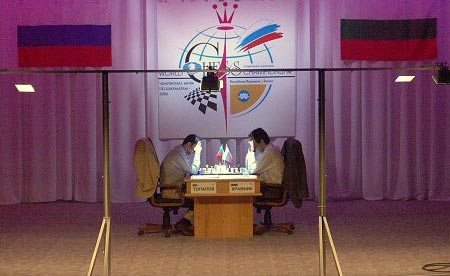
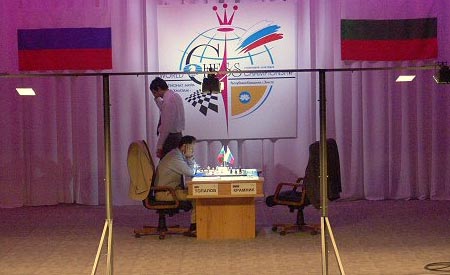

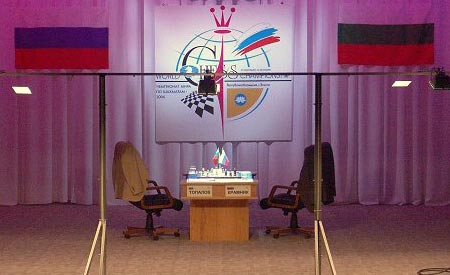
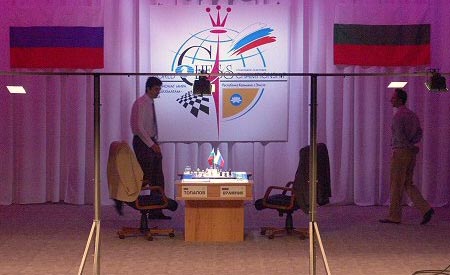
Did you enjoy yourself? We were tempted, but who wants to pour oil into
the fire?

Grandmasters watching the action on Playchess.com
Current standing
| Player |
Rating |
1 |
2 |
3 |
4 |
5 |
6 |
7 |
8 |
9 |
10 |
11 |
12 |
Tot. |
Perf. |
| Veselin Topalov |
2813 |
0 |
0 |
½ |
½ |
(1) |
½ |
½ |
|
|
|
|
|
3
|
2623
|
| Vladimir Kramnik |
2743 |
1 |
1 |
½ |
½ |
(0) |
½ |
½ |
|
|
|
|
|
4
|
2933
|
| New schedule of the World Chess Championship 2006 |
| Day 1 |
Thurs.. |
21 Sept |
7:00 p.m. |
Opening ceremony |
| Day 2 |
Friday |
22 Sept. |
|
Rest day |
| Day 3 |
Sat. |
23 Sept. |
3:00 p.m. |
Game 1 |
| Day 4 |
Sun. |
24 Sept. |
3:00 p.m. |
Game 2 |
| Day 5 |
Mon. |
25 Sept. |
|
Rest day |
| Day 6 |
Tues. |
26 Sept. |
3:00 p.m. |
Game 3 |
| Day 7 |
Wed. |
27 Sept. |
3:00 p.m. |
Game 4 |
| Day 8 |
Thurs. |
28 Sept. |
|
Rest day |
| Day 9 |
Friday |
29 Sept. |
3:00 p.m. |
Game 5 (forfeit) |
|
Protest interruption |
| Day 10 |
Mon. |
2 Oct. |
3:00 p.m. |
Game 6 |
| Day 11 |
Tues. |
3 Oct. |
|
Rest day |
| Day 12 |
Wed. |
4 Oct. |
3:00 p.m. |
Game 7 |
| Day 13 |
Thurs. |
5 Oct. |
3:00 p.m. |
Game 8 |
| Day 14 |
Friday |
6 Oct. |
|
Rest day |
| Day 16 |
Sat. |
7 Oct. |
3:00 p.m. |
Game 9 |
| Day 17 |
Sun. |
8 Oct |
3:00 p.m. |
Game 10 |
| Day 18 |
Mon. |
9 Oct |
|
Rest day |
| Day 19 |
Tues. |
10 Oct |
3:00 p.m |
Game 11 |
| Day 20 |
Wed. |
11 Oct |
|
Rest day |
| Day 21 |
Thurs. |
12 Oct |
3:00 p.m. |
Game 12 |
| Day 22 |
Friday |
13 Oct |
3:00 p.m. |
Tiebreaks, closing |
Links



















